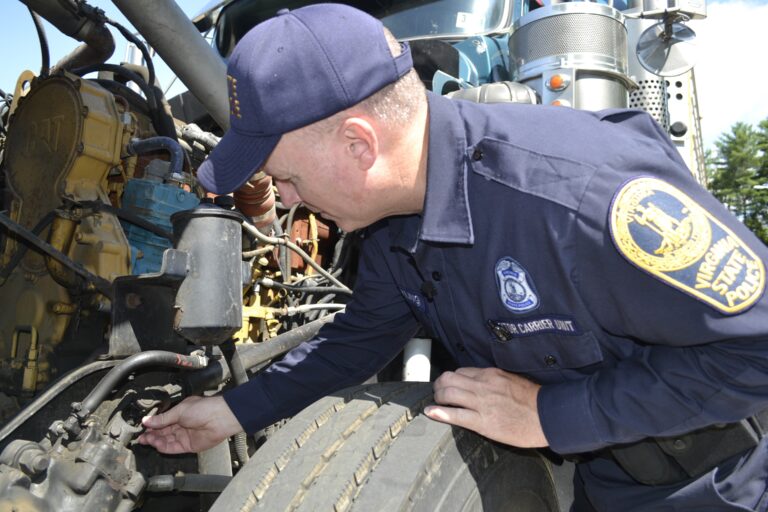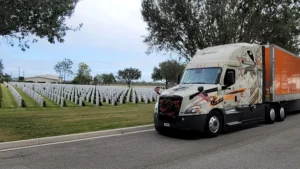GREENBELT, Md. — If the results of the Commercial Vehicle Safety Alliance’s 2019 International Roadcheck are any indication, the trucking industry still has work to do on some vehicle compliance issues.
The CVSA said August 29 that 12,019 vehicles were removed from roadways because of critical vehicle inspection item violations compared with 11,910 in 2018, while the total number of inspections declined from 67,603 in 2018 to 67,072.
That’s a very slight increase, but an increase nevertheless.
CVSA said 2,784 drivers were placed out of service for driver-related violations compared with 2,666 in 2018. Again, it’s a a slight increase, but an increase nevertheless.
In 2019, there was a 17.9% overall vehicle OOS rate and a 4.2% driver OOS rate,
compared with a 17.6% overall vehicle OOS rate and a 3.9% driver OOS rate in 2018.
International Roadcheck is an annual 72-hour inspection and enforcement safety event that identifies and removes unsafe commercial motor vehicles and drivers from our roadways, highlights the daily work of the 13,000-plus commercial motor vehicle inspectors throughout North America and acknowledges the safety compliance of motor carriers and professional drivers through the affixion of the CVSA decal on eligible vehicles.
Despite the slight increases in vehicle and driver OOS rates, Will Schaefer, director of safety programs at CVSA, stressed that Roadcheck is about more than just numbers.
“One of the beneficial outcomes of our inspection and enforcement event is that it reminds commercial motor vehicle owners and operators of the importance of vehicle maintenance and fixing mechanical issues when they arise, and it reminds drivers of the importance of conducting pre- and post-trip inspections,” Schaefer said. “Some vehicles might not be as well maintained if there was not this annual event when vehicles are more likely to be checked with a roadside safety inspection. It is a little disappointing to see the OOS remaining at around one in five vehicles checked, but that’s why our work needs to continue.”
Jack Van Steenburg, chief safety officer and assistant administrator at the Federal Motor Carrier Safety Administration, which is heavily involved in Roadcheck, compared the Roadcheck results with national OOS rates, but noted one major disappointment.
“The 2019 Roadcheck results indicated lower driver and vehicle OOS rates than the national average,” he said. “This year during Roadcheck the driver OOS rate was 4.2% compared to the national average of 4.9%, while the vehicle OOS rate was 17.2% compared to the national average OOS rate of 21%. The big disappointment was that 748 citations were written for seat belt violations; one violation is one too many. In 2017, at least 36% of large-truck occupants who were killed were not restrained by a safety belt.”
Both Schaefer and Van Steenburg stressed that in addition to enforcement, Roadcheck is an educational endeavor that is important in lowering OOS rates in the future.
“What is not mentioned in reporting the numbers is all the education that occurs during road checks and the partnerships that goes on between the enforcement community and the motor carrier industry,” Van Steenburg said. “There are so many variables that can impact OOS rates and to speculate won’t help. Together, we need to continue to collaborate, assure industry has strong systematic inspection, repair and maintenance programs, conducts quality pre-inspections, and promotes a strong safety culture atmosphere for all their personnel.”
Schaefer said CVSA continues to document the vehicle conditions that are found in the inspection process so that drivers, owner-operators, carriers and researchers can more effectively address the root causes.
He noted that Roadcheck covers all facets of the transportation industry.
International Roadcheck is not only checking over-the-road drivers and trucks but also everyday delivery vans, construction and vocational trucks, trucks in and out of ports, motor coaches and any other commercial motor vehicle operations on public roadways, he said.
During an inspection, if an inspector identifies critical vehicle inspection item out-of-service violations, he or she will render the vehicle out of service, which means those mechanical defects must be corrected before the vehicle is permitted to proceed. A driver found to be in violation of the driver-related conditions in the CVSA North American Standard Out-of-Service Criteria will be placed out of service until the condition can be rectified.
During International Roadcheck, inspectors primarily conducted one of three inspection levels:
- The North American Standard (NAS) Level I Inspection is a 37-step procedure that includes an examination of driver operating requirements and vehicle mechanical fitness. In 2019, there were 45,568 Level I inspections conducted in the U.S. and Canada; 21.5% (9,817) of those inspected vehicles were placed OOS.
- The NAS Level II Inspection typically includes everything that can be inspected without physically getting under the vehicle.
- The NAS Level III Inspection is a review of driver requirements, such as the license, additional operating credentials, applicable cargo and vehicle documentation, record of duty status, seat belt usage, etc.
CVSA gathered and analyzed data from the three days of International Roadcheck from the U.S. Federal Motor Carrier Safety Administration’s Motor Carrier Management Information System and pooled that data with data collected and submitted by CVSA’s Canadian jurisdictions to report overall statistics from Canada and the U.S. for International Roadcheck.
- There were 60,058 Level I, II and III inspections conducted in the U.S.
- There were 7,014 Level I, II and III inspections conducted in Canada.
- The total vehicle out-of-service rate in the U.S. was 17.7%.
- The total vehicle out-of-service rate in Canada was 19.9%.
- 4.4% of drivers inspected in the U.S. were placed out of service.
- 2% of drivers inspected in Canada were placed out of service.
Each year, special emphasis is placed on a certain category of violations, with this year’s emphasis being on steering and suspension systems.
While checking those vehicle components is always part of the North American Standard Inspection, CVSA selected steering components and suspension systems as a reminder of their importance to vehicle safety and fitness.
Inspectors identified 408 steering (2.5% of all out-of-service vehicle violations) and 703 suspension (4.3% of all out-of-service vehicle violations) out-of-service vehicle conditions during International Roadcheck.
Of the 67,072 inspections conducted during International Roadcheck, there were 16,347 out-of-service vehicle conditions (some vehicles had multiple OOS violations). The vehicle portion of an inspection includes checking critical vehicle inspection items such as: brake systems; cargo securement; coupling devices; driveline/driveshaft; driver’s seat (missing); exhaust systems; frames; fuel systems; lighting devices (headlamps, tail lamps, stop lamps, turn signals and lamps/flags on projecting loads); steering mechanisms; suspensions; tires; van and open-top trailer bodies; wheels, rims, and hubs; and windshield wipers.
Since December 17, 2017, the U.S. Department of Transportation requires the use of electronic logging devices in commercial motor vehicles involved in interstate commerce when operated by drivers who are required to keep hours-of-service records of duty status. The ELD mandate did not, however, change any of the underlying hours-of-service rules, regulations, requirements, exemptions or exceptions.
There were 3,851 commercial motor vehicles transporting hazardous materials/dangerous goods (HM/DG) were inspected during International Roadcheck. Inspections of HM/DG include, in addition to the standard Level I vehicle and driver items, checking for compliance of shipping papers, placarding, marking, labeling, packaging and loading.
There were 527 HM/DG vehicles with out-of-service conditions, which is a 13.7% out-of-service rate for HM/DG vehicles.
There were 52 HM/DG drivers placed out-of-service; that’s a 1.4% out-of-service rate for HM/DG drivers.
Since its inception in 1988, more than 1.7 million roadside inspections have been conducted during International Roadcheck campaigns. International Roadcheck is a CVSA program with participation by FMCSA, Canadian Council of Motor Transport Administrators, Transport Canada and Secretaría de Comunicaciones y Transportes (SCT) (Ministry of Communications and Transportation) of Mexico.
The Trucker News Staff produces engaging content for not only TheTrucker.com, but also The Trucker Newspaper, which has been serving the trucking industry for more than 30 years. With a focus on drivers, the Trucker News Staff aims to provide relevant, objective content pertaining to the trucking segment of the transportation industry. The Trucker News Staff is based in Little Rock, Arkansas.















